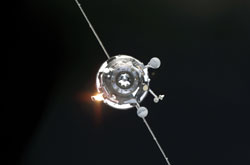The Progress spacecraft will take off from Baikonur about a week before the launch of the space shuttle Endeavor to the space station on mission STS-118

In the photo: an unmanned supply spacecraft of the Progress model approaches the space station in May 2007. Photo: NASA
Among the dry cargo are also spare parts for the Russian computers that suffered problems during the STS-117 mission of the space shuttle Atlantis in June and caused electrical failures. The spacecraft is scheduled to dock with the station on Sunday, August 5 at around 14:38 EST (21:38 Israel time).
The spacecraft will use the automatic navigation system installed outside the spacecraft component. 15th crew commander Fyodor Yurchikhin will manually activate the docking control, in case his intervention is required. After that, Yurchikhin, Oleg Kotov and Clayton Anderson will unload the cargo, fill the spacecraft with garbage and objects that are no longer needed at the station, it will leave the station and aim for the atmosphere where it will burn up.
The Progress spacecraft is similar in appearance and in some design elements to the Soyuz spacecraft, which brings the crew members to the station and is also used as a rescue ship in the event of an urgent return to Earth. The spacecraft's stern module, equipment and propulsion system are almost identical between the two spacecraft. But the upper two thirds - the middle part used for refueling and the upper part is the trunk. In the Soyuz, the passenger cabin, which also returns to Earth, is the middle component and the other component is the orbital module.
